Anomaly Detection of Remote Sensing Images Based on the Channel Attention Mechanism and LRX
Abstract
1. Introduction
- (1)
- The channel attention module is proposed to explore the effective bands of HSIs, enhancing the representation of different land covers in the reconstructed image generated by the auto-encoder network.
- (2)
- The LRX algorithm is employed for anomaly detection on the reconstructed image, which effectively alleviates the impact of existing noises in HSIs.
- (3)
- The effectiveness of the proposed hyperspectral anomaly detection algorithm based on the channel attention model and LRX is verified on three hyperspectral datasets, HYDICE, AVIRIS, and Salinas, with AUC values of 0.9871, 0.9916, and 0.9642, respectively.
2. Related Work
2.1. Auto-Encoder Network
2.2. Channel Attention Mechanism
2.3. LRX Algorithm
3. Hyperspectral Anomaly Detection Based on the Channel Attention Mechanism and LRX
3.1. Channel Attention Network
3.2. Auto-Encoder Network
3.3. LRX-Based Anomaly Detection
4. Experimental Results and Analysis
4.1. Dataset
- (1)
- HYDICE urban dataset: The HYDICE urban dataset is widely used in hyperspectral anomaly detection and is acquired by the hyperspectral digital image acquisition experiment sensor. The original image size is . After removing noise and bands affected by water absorption, 160 bands were retained. In this paper, the original images are cropped to obtain a dataset with the size of . Figure 2 shows the visualization of HYDICE urban data and their corresponding ground truth.
- (2)
- AVIRIS airplane dataset: the AVIRIS aircraft dataset is acquired from the Infrared Imaging Spectrometer in San Diego, CA, USA. The AVIRIS airplane dataset has a spatial resolution of 20 m and a spectral resolution of 10 nm, with a spectral wavelength range from 370 nm to 2510 nm. The AVIRIS aircraft dataset has a spatial size of , with 224 bands. Considering the absorption region, low signal-to-noise ratio and damaged bands, 189 bands are reserved for experiments. Figure 3 illustrates the visualization of the AVIRIS airplane dataset and its corresponding ground truth.
- (3)
- Salinas Valley dataset: The Salinas Valley dataset captures an image of the Salinas Valley in California, USA, taken by the AVIRIS imaging spectrometer. The original image size is , and the dataset is cropped to obtain dimensions of . Figure 4 presents a visual display of the Salinas Valley dataset and its corresponding ground truth.
4.2. Evaluation Criteria
4.3. Comparison with State-of-the-Arts
- (1)
- The LRX algorithm is similar to the GRX algorithm. However, the LRX applies a double window sliding strategy to detect anomalies, reducing the effect of the overall background noise [30].
- (2)
- BJSR constructs overcomplete background dictionaries using background samples. It detects anomalies by computing the reconstruction error and estimating adaptive orthogonal background complementary subspaces [16].
- (3)
- LRaSMD decomposes the input image into a low-rank matrix representing the background and a sparse matrix representing the anomaly by low rank decomposition. It constructs the background and calculates the Mahalanobis distance based on the background statistics to detect anomalies [15].
- (4)
- MCRD uses residuals to detect anomalies by removing pixels whose spectrum are significantly different from the majority of pixels in the background, aiming to obtain more representative background pixels [31].
- (5)
- AE-based algorithm employs an encoder–decoder network to extract features and reconstructs the original image. Anomalies are detected by calculating the reconstruction errors [32].
- (6)
- AUTO-AD algorithm reconstructs the background by a fully convolutional auto-encoder with skip connections. Anomaly detection is performed by analyzing the difference between the generated map and the original image [23].
5. Conclusions
Author Contributions
Funding
Conflicts of Interest
References
- Wang, W.; Zhao, B.; Feng, F.; Nan, J.; Li, C. Hierarchical Sub-Pixel Anomaly Detection Framework for Hyperspectral Imagery. Sensors 2018, 18, 3662. [Google Scholar] [CrossRef] [PubMed]
- Racetin, I.; Krtalić, A. Systematic review of anomaly detection in hyperspectral remote sensing applications. Appl. Sci. 2021, 11, 4878. [Google Scholar] [CrossRef]
- Li, Q.; Wang, F.; Wang, Y.; Zhou, C.; Chen, J.; Forson, K.; Miao, R.; Su, Y.; Zhang, J. Effect of reservoir characteristics and chemicals on filtration property of water-based drilling fluid in unconventional reservoir and mechanism disclosure. Environ. Sci. Pollut. Res. 2023, 30, 55034–55043. [Google Scholar] [CrossRef]
- Li, Q.; Wang, F.; Wang, Y.; Bai, B.; Zhang, J.; Lili, C.; Sun, Q.; Wang, Y.; Forson, K. Adsorption behavior and mechanism analysis of siloxane thickener for CO2 fracturing fluid on shallow shale soil. J. Mol. Liq. 2023, 376, 121394. [Google Scholar] [CrossRef]
- Li, Q.; Wu, J. Factors affecting the lower limit of the safe mud weight window for drilling operation in hydrate-bearing sediments in the Northern South China Sea. Geomech. Geophys. Geo-Energy Geo-Resour. 2022, 8, 82. [Google Scholar] [CrossRef]
- Zhang, X.; Ma, X.; Huyan, N.; Gu, J.; Tang, X.; Jiao, L. Spectral-Difference Low-Rank Representation Learning for Hyperspectral Anomaly Detection. IEEE Trans. Geosci. Remote Sens. 2021, 59, 10364–10377. [Google Scholar] [CrossRef]
- Molero, J.M.; Garzón, E.M.; García, I.; Plaza, A. Analysis and Optimizations of Global and Local Versions of the RX Algorithm for Anomaly Detection in Hyperspectral Data. IEEE J. Sel. Top. Appl. Earth Obs. Remote Sens. 2013, 6, 801–814. [Google Scholar] [CrossRef]
- Dora, C.; Majumdar, J. Analysis of Versions of the RX Algorithm for Anomaly Detection in Hyperspectral Images. Curr. J. Appl. Sci. Technol. 2021, 40, 25–31. [Google Scholar] [CrossRef]
- Hidalgo, J.A.P.; Pérez-Suay, A.; Nar, F.; Camps-Valls, G. Efficient nonlinear RX anomaly detectors. IEEE Geosci. Remote Sens. Lett. 2020, 18, 231–235. [Google Scholar] [CrossRef]
- Kwon, H.; Nasrabadi, N.M. Kernel RX-algorithm: A nonlinear anomaly detector for hyperspectral imagery. IEEE Trans. Geosci. Remote Sens. 2005, 43, 388–397. [Google Scholar] [CrossRef]
- Padrón-Hidalgo, J.A.; Laparra, V.; Camps-Valls, G. Unsupervised anomaly and change detection with multivariate gaussianization. IEEE Trans. Geosci. Remote Sens. 2021, 60, 1–10. [Google Scholar] [CrossRef]
- Li, W.; Du, Q. Collaborative Representation for Hyperspectral Anomaly Detection. IEEE Trans. Geosci. Remote Sens. 2015, 53, 1463–1474. [Google Scholar] [CrossRef]
- Wu, Z.; Su, H.; Tao, X.; Han, L.; Paoletti, M.E.; Haut, J.M.; Plaza, J.; Plaza, A. Hyperspectral Anomaly Detection With Relaxed Collaborative Representation. IEEE Trans. Geosci. Remote Sens. 2022, 60, 1–17. [Google Scholar] [CrossRef]
- Li, J.; Zhang, H.; Zhang, L.; Ma, L. Hyperspectral Anomaly Detection by the Use of Background Joint Sparse Representation. IEEE J. Sel. Top. Appl. Earth Obs. Remote Sens. 2015, 8, 2523–2533. [Google Scholar] [CrossRef]
- Sun, W.; Liu, C.; Li, J.; Lai, Y.M.; Li, W. Low-rank and sparse matrix decomposition-based anomaly detection for hyperspectral imagery. J. Appl. Remote Sens. 2014, 8, 083641. [Google Scholar] [CrossRef]
- Wu, C.; Du, B.; Zhang, L. Hyperspectral anomalous change detection based on joint sparse representation. ISPRS J. Photogramm. Remote Sens. 2018, 146, 137–150. [Google Scholar] [CrossRef]
- Ruhan, A.; Mu, X.; He, J. Enhance Tensor RPCA-Based Mahalanobis Distance Method for Hyperspectral Anomaly Detection. IEEE Geosci. Remote Sens. Lett. 2022, 19, 1–5. [Google Scholar]
- Zhang, L.; Cheng, B. Transferred CNN Based on Tensor for Hyperspectral Anomaly Detection. IEEE Geosci. Remote Sens. Lett. 2020, 17, 2115–2119. [Google Scholar] [CrossRef]
- Arisoy, S.; Nasrabadi, N.M.; Kayabol, K. GAN-based Hyperspectral Anomaly Detection. In Proceedings of the 2020 28th European Signal Processing Conference (EUSIPCO), Amsterdam, The Netherlands, 18–21 January 2021; pp. 1891–1895. [Google Scholar] [CrossRef]
- Zhao, C.; Li, X.; Zhu, H. Hyperspectral anomaly detection based on stacked denoising autoencoders. J. Appl. Remote Sens. 2017, 11, 042605. [Google Scholar] [CrossRef]
- Zhao, Z.; Sun, B. Hyperspectral anomaly detection via memory-augmented autoencoders. CAAI Trans. Intell. Technol. 2022, 1–14. [Google Scholar] [CrossRef]
- Shi, C.; Liao, D.; Zhang, T.; Wang, L. Hyperspectral Image Classification Based on 3D Coordination Attention Mechanism Network. Remote Sens. 2022, 14, 608. [Google Scholar] [CrossRef]
- Wang, S.; Wang, X.; Zhang, L.; Zhong, Y. Auto-AD: Autonomous Hyperspectral Anomaly Detection Network Based on Fully Convolutional Autoencoder. IEEE Trans. Geosci. Remote Sens. 2022, 60, 1–14. [Google Scholar] [CrossRef]
- Lu, X.; Zhang, W.; Huang, J. Exploiting Embedding Manifold of Autoencoders for Hyperspectral Anomaly Detection. IEEE Trans. Geosci. Remote Sens. 2020, 58, 1527–1537. [Google Scholar] [CrossRef]
- Xie, W.; Liu, B.; Li, Y.; Lei, J.; Du, Q. Autoencoder and Adversarial-Learning-Based Semisupervised Background Estimation for Hyperspectral Anomaly Detection. IEEE Trans. Geosci. Remote Sens. 2020, 58, 5416–5427. [Google Scholar] [CrossRef]
- Bati, E.; Çalışkan, A.; Koz, A.; Alatan, A.A. Hyperspectral anomaly detection method based on auto-encoder. In Proceedings of the Image and Signal Processing for Remote Sensing XXI, Toulouse, France, 21–23 September 2015; Bruzzone, L., Ed.; International Society for Optics and Photonics, SPIE: Bellingham, WA, USA, 2015; Volume 9643, p. 96430N. [Google Scholar] [CrossRef]
- Guo, R.; Xiao, P.; Zhang, X.; Liu, H. Updating land cover map based on change detection of high-resolution remote sensing images. J. Appl. Remote Sens. 2021, 15, 044507. [Google Scholar] [CrossRef]
- Li, X.; Zhao, C.; Yang, Y. Hyperspectral anomaly detection based on the distinguishing features of a redundant difference-value network. Int. J. Remote Sens. 2021, 42, 5455–5473. [Google Scholar] [CrossRef]
- Vafadar, M.; Ghassemian, H. Anomaly Detection of Hyperspectral Imagery Using Modified Collaborative Representation. IEEE Geosci. Remote Sens. Lett. 2018, 15, 577–581. [Google Scholar] [CrossRef]
- Küçük, S.; Yüksel, S.E. Comparison of RX-based anomaly detectors on synthetic and real hyperspectral data. In Proceedings of the 2015 7th Workshop on Hyperspectral Image and Signal Processing: Evolution in Remote Sensing (WHISPERS), Tokyo, Japan, 2–5 June 2015; pp. 1–4. [Google Scholar] [CrossRef]
- Ma, N.; Peng, Y.; Wang, S. A Fast Recursive Collaboration Representation Anomaly Detector for Hyperspectral Image. IEEE Geosci. Remote Sens. Lett. 2019, 16, 588–592. [Google Scholar] [CrossRef]
- Xie, W.; Lei, J.; Liu, B.; Li, Y.; Jia, X. Spectral constraint adversarial autoencoders approach to feature representation in hyperspectral anomaly detection. Neural Netw. 2019, 119, 222–234. [Google Scholar] [CrossRef]

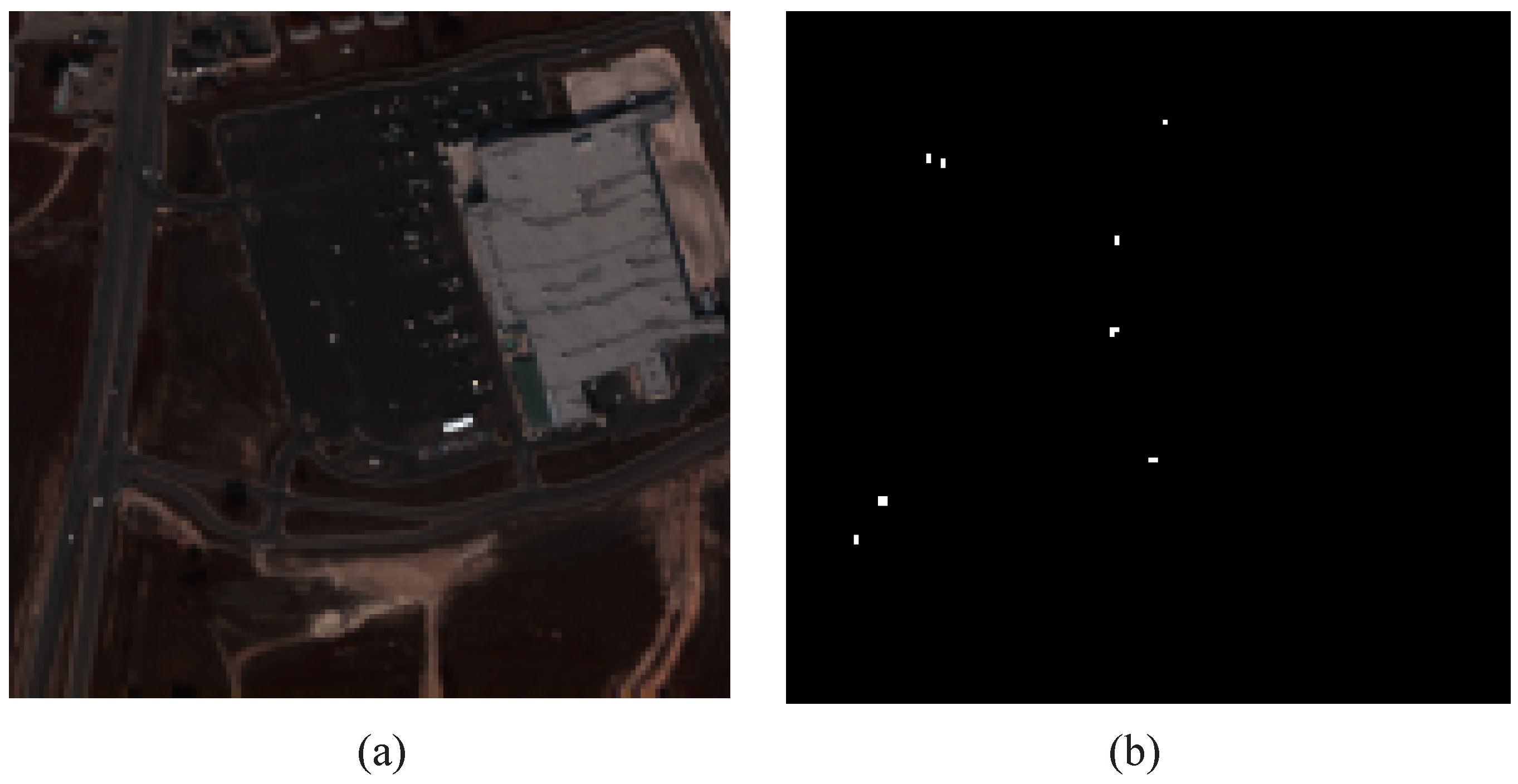
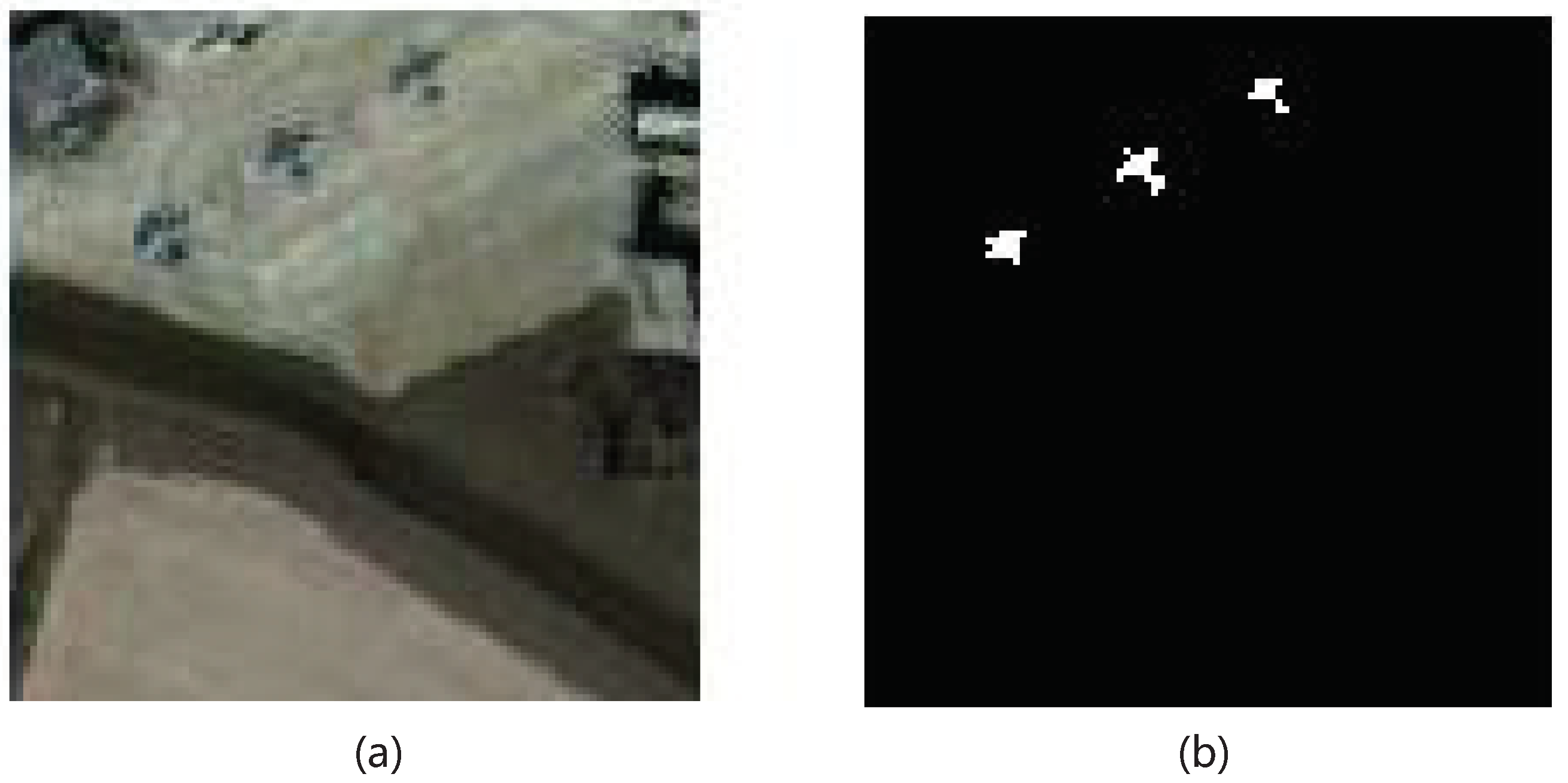


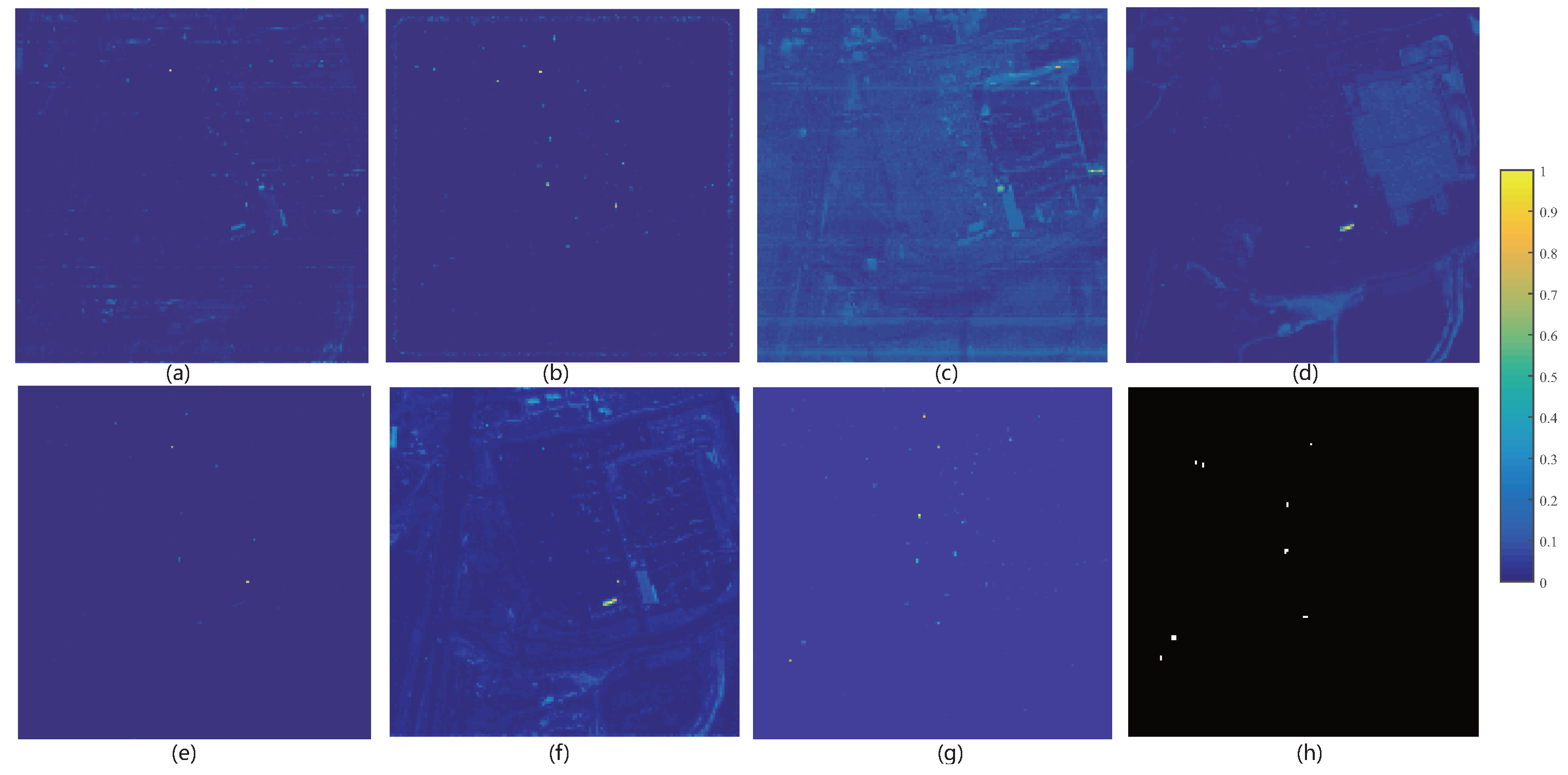
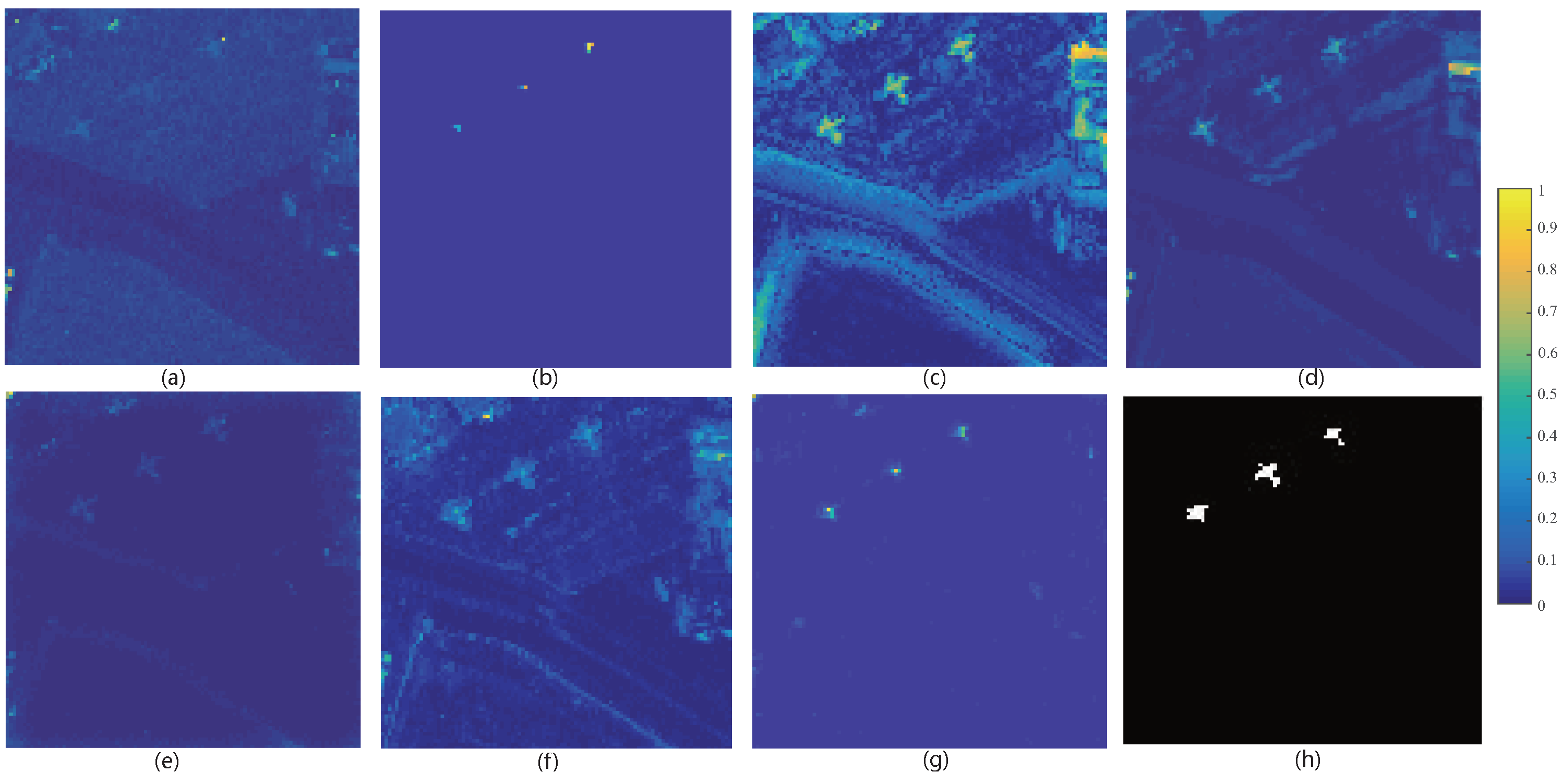
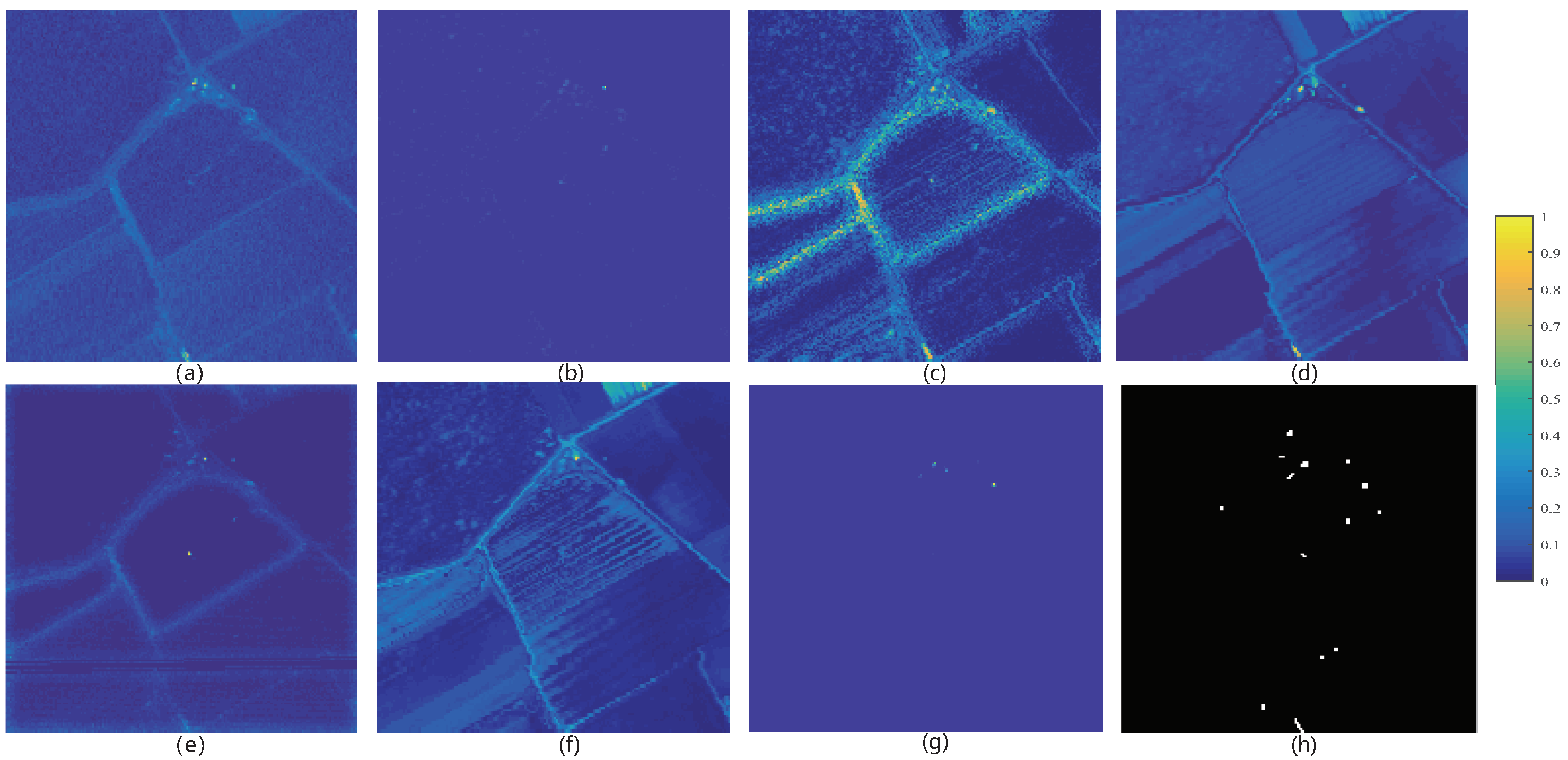
| Name | Output Size | Activation Function |
|---|---|---|
| Input | ||
| Dense | RELU | |
| Dense | RELU | |
| Dense | RELU | |
| Dense Z | RELU | |
| Dense | RELU | |
| Dense | RELU | |
| Dense | RELU | |
| Output |
| Method | Dataset | ||
|---|---|---|---|
| HYDICE Urban | AVIRIS Airplane | Salinas Scene | |
| LRX | |||
| BJSR | |||
| LRaSMD | |||
| MCRD | |||
| AE-based | |||
| AUTO-AD | |||
| Ours | |||
Disclaimer/Publisher’s Note: The statements, opinions and data contained in all publications are solely those of the individual author(s) and contributor(s) and not of MDPI and/or the editor(s). MDPI and/or the editor(s) disclaim responsibility for any injury to people or property resulting from any ideas, methods, instructions or products referred to in the content. |
© 2023 by the authors. Licensee MDPI, Basel, Switzerland. This article is an open access article distributed under the terms and conditions of the Creative Commons Attribution (CC BY) license (https://creativecommons.org/licenses/by/4.0/).
Share and Cite
Guo, H.; Wang, H.; Song, X.; Ruan, Z. Anomaly Detection of Remote Sensing Images Based on the Channel Attention Mechanism and LRX. Appl. Sci. 2023, 13, 6988. https://doi.org/10.3390/app13126988
Guo H, Wang H, Song X, Ruan Z. Anomaly Detection of Remote Sensing Images Based on the Channel Attention Mechanism and LRX. Applied Sciences. 2023; 13(12):6988. https://doi.org/10.3390/app13126988
Chicago/Turabian StyleGuo, Huinan, Hua Wang, Xiaodong Song, and Zhongling Ruan. 2023. "Anomaly Detection of Remote Sensing Images Based on the Channel Attention Mechanism and LRX" Applied Sciences 13, no. 12: 6988. https://doi.org/10.3390/app13126988
APA StyleGuo, H., Wang, H., Song, X., & Ruan, Z. (2023). Anomaly Detection of Remote Sensing Images Based on the Channel Attention Mechanism and LRX. Applied Sciences, 13(12), 6988. https://doi.org/10.3390/app13126988





